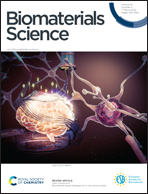Nine days extended release of adenosine from biocompatible MOFs under biologically relevant conditions†
Abstract
Adenosine is a small molecule directly involved in maintaining homeostasis under pathological and stressful conditions. Due to its rapid metabolism, delivery vehicles capable of exhibiting extended release of adenosine are of paramount interest. Herein, we demonstrate a superior long-term (9 days) release profile of adenosine from biocompatible MOFs in a physiologically relevant environment. The key to the biocompatibility of MOFs is their stability under biologically relevant conditions. This study additionally highlights the interplay between the chemical stability of prototypal MOFs, assessed under physiological conditions, and their cytotoxicity profiles. Cytotoxicity of the prototypal Zn-based MOF (ZIF-8) and three Zr-based MOFs (UiO-66, UiO-66-NH2, and MOF-801) on six cell types was assessed. The cell types selected were valve interstitial cells (VICs), valve endothelial cells (VECs), adipose tissue-derived stem cells (ADSCs), and cell lines U937, THP1, and HeLa. Zr-based MOFs demonstrated a wide tolerance range in the cell culture cytotoxicity assays, demonstrating cell viability up to a very high dose of ∼1000 μg mL−1, as compared to ZIF-8 which showed notable cytotoxicity in as little as ∼100 μg mL−1 dose. This study demonstrates, for the first time, the utilization of biocompatible MOFs for adenosine delivery as well as establishes a direct link between structural instability in the cell culture medium and the observed cytotoxicity of the studied MOFs.



 Please wait while we load your content...
Please wait while we load your content...